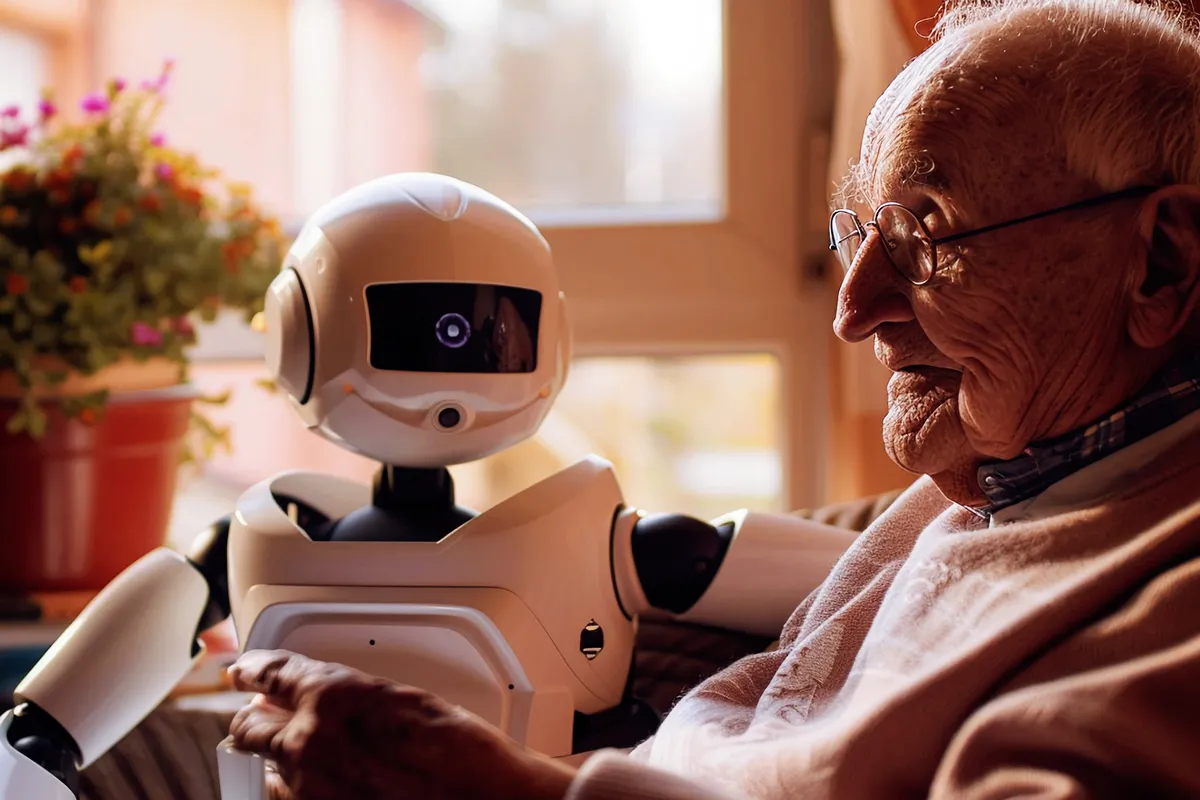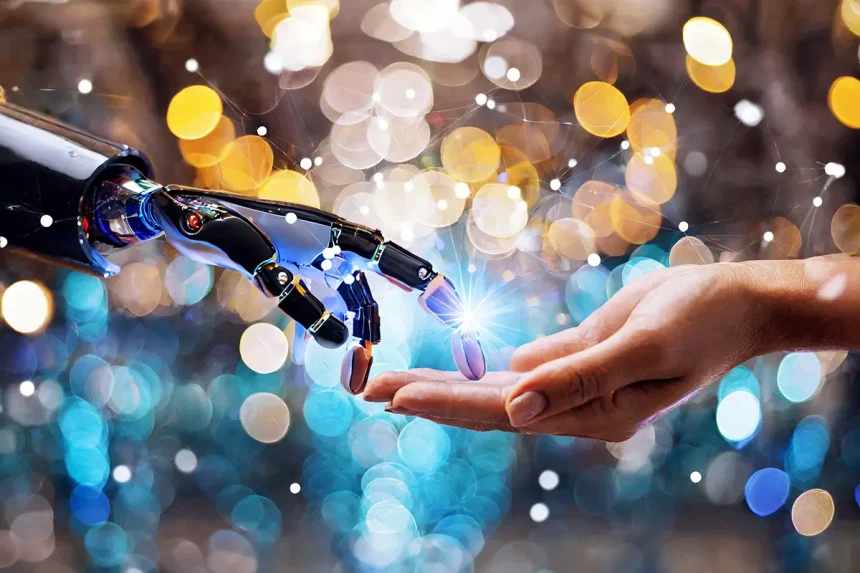Imagine a world where your 90-year-old neighbor runs marathons, thanks to smart robotic legs. Picture your grandpa’s health being looked after by a computer program so clever it can spot health problems before they happen. Think about a 100-year-old artist creating masterpieces using just her thoughts, connected directly to a computer.
Welcome to a new way of getting older, where smart computers are changing everything we thought we knew about aging.
Remember when getting older meant slowing down? Those days are gone. We’re now entering a time when the wisdom that comes with age is teaming up with incredibly smart technology to make things possible that we once thought could only happen in movies.
This isn’t just about living longer. It’s about living better as we age. Smart computers are turning the world of technology for older adults into something exciting and full of possibilities. From tiny robots that can repair our brains to entire cities that change to meet the needs of older people, we’re seeing a whole new way of thinking about growing older.
And here’s the amazing part: this isn’t something that’s going to happen in the far-off future. It’s happening right now, in research labs, in people’s homes, and in cities all around the world. It’s not just changing how we age – it’s making us think differently about what it means to be human in a world where the line between people and technology is getting blurry.
Get ready to explore a world where your age is just a number, and where getting older means opening up a whole new world of opportunities.
Overview:
- AI is reshaping how we design technologies for aging populations.
- Machine learning algorithms are creating personalized assistive devices.
- AI-powered solutions are enhancing preventive care and cognitive support.
- Ethical considerations and regulatory frameworks are evolving alongside these innovations.
- The integration of AI agetech is transforming smart homes and cities.
The AI Revolution in Agetech Design
The interesting thing is, AI isn’t just changing the game – it’s creating a whole new playing field. Imagine a world where the devices and technologies we use as we age aren’t just helpful, they’re like extensions of ourselves. That’s the promise of AI-driven agetech innovation. AI doesn’t just process data, it learns from it. Machine learning algorithms are like sponges, soaking up information about how we age, how our needs change, and even how we interact with technology. They’re not just crunching numbers; they’re understanding patterns, predicting needs, and designing solutions that adapt as we do.
Get this – these algorithms can analyze millions of data points from sensors, wearables, and medical records. They’re piecing together a picture of aging that’s more detailed and nuanced than anything we’ve had before. It’s like having a supercomputer dedicated to understanding every aspect of growing older.
Now, let’s talk about how this understanding translates into actual products. AI isn’t just informing design; it’s actively participating in the creative process. We’re seeing AI systems that can generate and test thousands of design iterations in the time it would take a human designer to sketch out a handful. The result? Assistive technologies that are more intuitive, more personalized, and more effective than ever before. We’re talking about hearing aids that don’t just amplify sound, but use AI to focus on the voices you want to hear in a crowded room. Or smart walkers that can predict and prevent falls by analyzing your gait in real-time.
Let’s look at some real-world examples that are changing lives right now:
1. AI-powered exoskeletons: These devices use machine learning to adapt to an individual’s walking patterns, providing just the right amount of support to keep people mobile and independent.
2. Smart medication dispensers: AI algorithms track medication schedules, dosages, and potential interactions, reducing errors and improving adherence.
3. Cognitive assistants: These AI companions engage older adults in conversation, memory games, and cognitive exercises, helping to keep minds sharp and reduce social isolation.
You know what’s really exciting? AI is helping us break free from the one-size-fits-all approach that’s dominated agetech for too long. Traditional design often falls short because it can’t account for the incredible diversity of the aging experience. But AI? It thrives on diversity. AI-driven design can create products that adapt to individual needs, preferences, and even cultural backgrounds. It’s not about designing for the average older adult – because let’s face it, there’s no such thing. It’s about creating technologies that can flex and grow with each unique user.
AI-Powered Longevity Solutions
The thing is, AI isn’t just about making better gadgets. It’s about fundamentally changing how we approach the entire concept of aging and longevity. We’re moving from a reactive model of healthcare to a proactive one, where AI is our partner in staying healthy, active, and engaged for longer.
Here’s where things get really interesting. AI is turning our bodies into data generators, and that data is becoming our first line of defense against age-related health issues. Wearable devices powered by AI can track everything from heart rate and blood pressure to sleep patterns and activity levels. But the magic happens when AI analyzes this data over time. It can spot subtle changes that might indicate the early stages of a health problem, long before symptoms become noticeable.
For example, AI algorithms have been developed that can predict the onset of conditions like Alzheimer’s disease years before clinical diagnosis. They do this by analyzing patterns in speech, writing, and even how people move their mouse when using a computer. This isn’t just cool tech – it’s a game-changer for preventive care. It means we can start addressing potential health issues earlier, when they’re often easier and less expensive to treat.
Let’s talk about how AI is personalizing the aging process. We all know that diet and exercise are important, but what works for one person might not work for another. This is where AI shines. AI systems can analyze your genetic makeup, current health status, lifestyle, and even your gut microbiome to create highly personalized nutrition and exercise plans. These aren’t static plans either – they evolve as you do, adjusting based on how your body responds over time.
Imagine an AI nutritionist that knows exactly what foods will help you maintain muscle mass, keep your bones strong, and support your cognitive health. Or an AI fitness coach that can design exercise routines that are not just safe and effective, but that you’ll actually enjoy doing.
Now, let’s get into something really exciting – how AI is helping keep our minds sharp as we age. We’re not just talking about brain training apps (although those are getting smarter too). We’re talking about AI companions that can engage in meaningful conversations, challenge our thinking, and even provide emotional support. These AI companions are designed to adapt to an individual’s cognitive level and interests. They can engage in discussions about current events, play strategy games, or even help with creative projects like writing or art. The key is that they’re always learning and adjusting, providing just the right level of mental stimulation.
But it goes beyond just keeping the mind active. These AI systems can also monitor for signs of cognitive decline, alerting healthcare providers if they notice concerning changes in language use or problem-solving abilities.
Here’s where AI is literally helping people get back on their feet. Smart prosthetics and exoskeletons are using AI to provide more natural and intuitive movement for people with mobility challenges. These devices use machine learning algorithms to understand and predict the user’s intentions. They can adjust in real-time to changes in terrain, speed, or even the user’s fatigue level. This means people can move more naturally and with less mental effort.
For example, there are AI-powered prosthetic legs that can learn a person’s unique gait and adjust their resistance and power output accordingly. This not only makes walking more comfortable but also reduces the risk of falls and long-term joint problems.
The integration of AI in mobility assistance devices is not just about restoring function. It’s about giving people the confidence to engage fully in life, knowing their device will adapt to their needs in any situation.

The Future of Aging with AI-Designed Technologies
You know what? We’re just scratching the surface of what’s possible when we combine AI with agetech. The future isn’t just about individual devices or applications – it’s about creating entire environments that support and enhance the aging process.
Let’s zoom out and look at the big picture. AI isn’t just changing individual devices; it’s transforming our entire living spaces. Smart homes are becoming more than just convenient – they’re becoming proactive caregivers. Imagine a home that uses AI to monitor your movements, anticipate your needs, and adjust the environment accordingly. Lights that automatically brighten when you get up at night, floors that can detect and prevent falls, and kitchens that can remind you to stay hydrated or eat regularly.
But it doesn’t stop at the front door. Cities are getting smarter too, and AI is helping them become more age-friendly. We’re talking about traffic systems that give older pedestrians more time to cross the street, public transportation that adapts its routes based on the needs of older residents, and community spaces that use AI to facilitate social connections and reduce isolation.
Now, let’s address the elephant in the room. With all this AI in our lives, especially for vulnerable populations like the elderly, we need to talk ethics. How do we balance the benefits of AI with concerns about privacy, autonomy, and the potential for reduced human interaction? These are complex questions without easy answers. But here’s the thing – by addressing them head-on, we can shape the development of AI agetech in a way that respects and enhances human dignity.
Key ethical considerations include:
- Data privacy and security: How do we protect sensitive health data?
- Informed consent: How do we ensure older adults understand and agree to AI interventions?
- Maintaining human connection: How do we use AI to enhance, not replace, human caregiving?
- Equity and access: How do we ensure AI agetech benefits all older adults, not just the wealthy?
Here’s where things get really interesting from a societal perspective. AI agetech isn’t just about improving individual lives – it has the potential to transform entire healthcare systems. By shifting the focus to prevention and early intervention, AI could significantly reduce the cost burden of age-related health issues. We’re talking about fewer hospitalizations, less need for long-term care facilities, and more people staying independent for longer.
A recent study estimated that AI-driven preventive care could reduce healthcare costs for older adults by up to 30% over the next decade. That’s not just good for individuals – it’s a game-changer for how we approach healthcare funding and resource allocation as societies with aging populations.
Get this – we’re not just preparing for an aging population anymore. We’re preparing for a tech-savvy, AI-enhanced aging population. This shift has implications for everything from urban planning to workforce development. We need to start thinking about digital literacy programs for older adults, redesigning public spaces to accommodate AI-assisted mobility devices, training healthcare providers to work alongside AI systems, and developing new legal and regulatory frameworks for AI in eldercare.
The interesting thing is, this preparation isn’t just about accommodating older adults – it’s about creating a society that values and leverages the capabilities of all its members, regardless of age.
Challenges and Opportunities in AI Agetech Innovation
Let’s face it – no revolution comes without its challenges. But here’s the real deal: every challenge in AI agetech is also an opportunity for innovation, growth, and positive change.
The first hurdle we need to tackle is the digital divide. Not all older adults have equal access to or comfort with technology. This gap isn’t just about owning a smartphone – it’s about having the skills and confidence to use AI-powered devices that could significantly improve quality of life. Here’s where things get exciting: we’re seeing the development of intergenerational learning programs, pairing tech-savvy youth with older adults for mutual learning experiences.
There’s also a push for age-friendly design, creating interfaces that are intuitive and accessible, regardless of tech experience. And community tech hubs are popping up, providing spaces where older adults can explore and learn about new technologies in a supportive environment. By addressing the digital divide, we’re not just enabling access to AI agetech – we’re opening up new avenues for social connection, learning, and engagement for older adults.
Now, let’s talk about a big concern: privacy and security. AI agetech often deals with sensitive health data and can monitor very personal aspects of daily life. How do we harness the power of this data while protecting individual privacy? This challenge is driving innovations in federated learning, where AI models can learn from data without that data ever leaving the user’s device.
We’re also seeing the development of blockchain for health records, creating secure, decentralized systems for storing and sharing health data. And there’s a push for explainable AI, developing systems that can clearly communicate how they make decisions, building trust with users. The opportunity here isn’t just about protection – it’s about empowering older adults to take control of their data and use it to improve their own health outcomes.
You know what’s really interesting? The development of AI agetech is outpacing our ability to regulate it. This isn’t necessarily a bad thing – innovation often moves faster than legislation. But it does present a challenge: how do we ensure these technologies are safe, ethical, and effective? This challenge is spurring the development of adaptive regulation, frameworks that can evolve as quickly as the technology they govern.
We’re seeing international collaboration, with countries working together to develop consistent standards for AI in healthcare. And there’s a move towards ethical AI certifications, systems to verify that AI agetech meets certain ethical and safety standards. The opportunity here is to create a regulatory environment that protects older adults while still encouraging innovation and rapid development of beneficial technologies.
Here’s a key point: the goal of AI in agetech isn’t to replace human care, but to enhance it. The challenge – and the opportunity – is in figuring out how humans and AI can work together most effectively in caring for older adults. This is leading to exciting developments in AI-assisted caregiving, with tools that help human caregivers provide better, more personalized care.
We’re seeing the emergence of hybrid care models that combine AI monitoring with human intervention. And there’s a growing focus on AI training for healthcare professionals, preparing the next generation of caregivers to work alongside AI systems. The real opportunity here is to create care models that combine the efficiency and data-processing power of AI with the empathy, intuition, and complex reasoning of human caregivers.
The future of eldercare isn’t about choosing between human touch and technological efficiency. It’s about leveraging AI to free up human caregivers to focus on what they do best – providing empathy, companionship, and complex problem-solving.
The Human Element in AI-Driven Eldercare
Let’s zoom in on something crucial: amidst all this talk of AI and technology, we can’t lose sight of the human element. After all, the goal of AI agetech isn’t to create a sterile, robotic world for older adults. It’s to enhance and support the very human experience of aging.
Here’s the thing: loneliness and social isolation are major issues for many older adults. And while AI can help address these problems, we need to be careful that it doesn’t inadvertently make them worse. The challenge – and the opportunity – is to use AI to facilitate real human connections, not replace them.
Here’s how we’re seeing this play out: AI-powered social matching systems that connect older adults with others who share their interests and experiences.
Virtual reality social spaces are creating immersive environments where older adults can interact with friends and family, even if they’re physically far apart. And AI companions are being developed not as a replacement for human interaction, but as tools to encourage and enable more human-to-human contact. The key is to design these systems with the end goal of increasing real-world social interaction, not replacing it.
Now, let’s talk about a really fascinating area of development: teaching AI to understand and respond to human emotions. This is crucial in eldercare, where emotional support is often just as important as physical care. We’re seeing exciting progress in emotion recognition AI, systems that can detect subtle changes in facial expressions, tone of voice, and even physiological markers to understand a person’s emotional state.
There’s work being done on adaptive emotional responses, creating AI companions that can adjust their communication style based on the user’s emotional needs. And researchers are exploring empathy training for AI, using machine learning to help AI systems understand and respond appropriately to complex human emotions. The goal isn’t to create AI that feels emotions, but AI that can recognize and respond to human emotions in helpful ways.
Here’s a tricky question: how do we use AI to keep older adults safe without infringing on their independence? It’s a delicate balance, but one that AI is uniquely positioned to help with. We’re seeing innovative approaches like predictive safety systems, AI that can anticipate potential safety issues and provide gentle, non-intrusive interventions.
There’s a move towards customizable autonomy settings, allowing older adults (or their families) to decide how much assistance they want in different areas of their lives. And we’re seeing the development of graduated assistance, AI systems that can provide more help as it’s needed, rather than taking over tasks completely. The opportunity here is to create living environments that adapt to the changing needs of older adults, providing support where it’s needed while maintaining independence where possible.
You know what’s really important? Making sure that in our rush to innovate, we don’t lose sight of the individuality and dignity of older adults. AI agetech should enhance personal identity, not diminish it. This means developing technologies that can adapt to individual preferences, respect cultural differences, and support personal goals and values. It’s about using AI to empower older adults to continue living life on their own terms, rather than forcing them to conform to a one-size-fits-all model of aging.

Preparing for a Tech-Enhanced Aging Population
We’re on the cusp of a new era, folks. An era where aging and technology are so intertwined that we need to rethink everything from healthcare to urban planning. So, how do we prepare for this tech-enhanced aging population?
First up, education is key. We need to start integrating technology literacy into our concept of lifelong learning. This isn’t just about teaching older adults to use smartphones – it’s about creating a culture where continuous tech education is the norm for all ages. Imagine community centers offering AI and robotics classes alongside traditional art and exercise programs. Or intergenerational tech mentorship programs where younger folks and older adults learn from each other.
But it’s not just about individual learning. We need to prepare our workforce too. Healthcare providers, social workers, urban planners – they all need to understand how AI and agetech are changing the game. We’re talking about new specialties emerging at the intersection of gerontology and technology.
Universities are starting to offer courses in “digital gerontology” and “AI-assisted eldercare.” This isn’t just about adding a tech component to existing curricula – it’s about fundamentally rethinking how we approach aging in a tech-enhanced world.
Now, let’s talk infrastructure. Our cities and communities need to evolve to support this new reality. We’re not just talking about adding more charging stations for electric wheelchairs (although that’s important too). We’re looking at smart city designs that cater to tech-enhanced older adults. Think about public spaces with integrated AI systems that can adjust lighting, sound, and even surface textures to accommodate different needs. Or transportation systems that can seamlessly integrate with personal mobility devices, making it easier for everyone to get around.
The whole story isn’t just about adapting to new tech – it’s about proactively shaping it. We need to ensure that older adults have a voice in the development of these technologies from the get-go. This means involving seniors in design processes, conducting extensive user testing with diverse older populations, and creating feedback loops that allow for continuous improvement based on real-world use.
Here’s the real deal: preparing for a tech-enhanced aging population isn’t just about accommodating a demographic shift. It’s about embracing the opportunity to create a more inclusive, connected, and empowered society for people of all ages. It’s about recognizing that with the right tools and support, aging can be a period of continued growth, learning, and contribution.
The convergence of AI, agetech, and an aging population isn’t a challenge to be managed – it’s an opportunity to reimagine what it means to grow older in the 21st century. We have the chance to create a world where age is just a number, and where technology empowers us to live fuller, richer lives at every stage.
As we wrap up, let’s zoom out and look at the big picture. The AI revolution in agetech isn’t just about cool gadgets or smarter healthcare. It’s about fundamentally changing our relationship with aging itself. We’re moving from a model of aging that focuses on decline and loss to one that emphasizes potential, growth, and continued engagement.
This shift has profound implications. It challenges our assumptions about what older adults can do and be. It opens up new possibilities for intergenerational connections and knowledge sharing. And it pushes us to create a society that values and leverages the capabilities of all its members, regardless of age.
So, what’s next? The future of AI-powered agetech is limited only by our imagination and our commitment to ethical, human-centered innovation. As we continue to push the boundaries of what’s possible, let’s keep asking ourselves: How can we use these technologies not just to add years to life, but to add life to years? How can we ensure that the benefits of these innovations are accessible to all, not just the privileged few? And how can we use AI and agetech to create a world where aging is seen not as a burden, but as an opportunity for continued growth, learning, and contribution?
These are big questions, and answering them will require collaboration across disciplines, generations, and cultures. But that’s the exciting part. We’re not just designing new technologies – we’re designing the future of aging itself. And that future looks brighter, more connected, and more empowering than ever before.
Remember, the goal isn’t to create a world where technology takes over the aging process. It’s to create a world where technology enhances our human capacity for care, connection, and growth throughout our entire lifespan. As we move forward into this AI-enhanced future of aging, let’s keep our focus on using these powerful tools to support what matters most: our shared humanity.
















